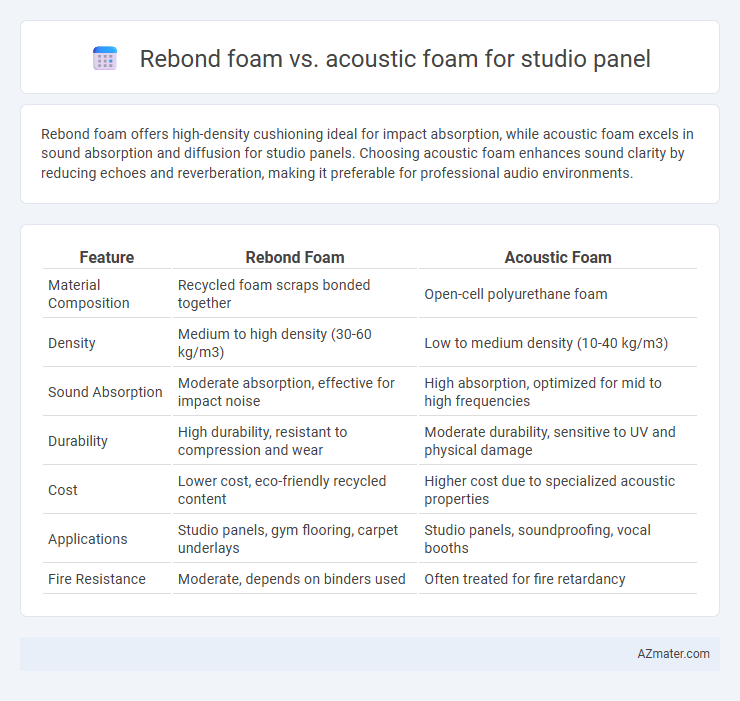Rebond foam offers high-density cushioning ideal for impact absorption, while acoustic foam excels in sound absorption and diffusion for studio panels. Choosing acoustic foam enhances sound clarity by reducing echoes and reverberation, making it preferable for professional audio environments.
Table of Comparison
| Feature | Rebond Foam | Acoustic Foam |
|---|---|---|
| Material Composition | Recycled foam scraps bonded together | Open-cell polyurethane foam |
| Density | Medium to high density (30-60 kg/m3) | Low to medium density (10-40 kg/m3) |
| Sound Absorption | Moderate absorption, effective for impact noise | High absorption, optimized for mid to high frequencies |
| Durability | High durability, resistant to compression and wear | Moderate durability, sensitive to UV and physical damage |
| Cost | Lower cost, eco-friendly recycled content | Higher cost due to specialized acoustic properties |
| Applications | Studio panels, gym flooring, carpet underlays | Studio panels, soundproofing, vocal booths |
| Fire Resistance | Moderate, depends on binders used | Often treated for fire retardancy |
Introduction: Understanding Studio Foam Choices
Rebond foam and acoustic foam serve distinct purposes in studio panel applications, with rebond foam offering superior durability and density for impact absorption and structural support. Acoustic foam excels in sound absorption by minimizing reflections and reverberations, improving overall room acoustics and audio clarity. Choosing between these materials depends on specific studio needs such as soundproofing effectiveness, panel longevity, and acoustic treatment goals.
What Is Rebond Foam?
Rebond foam is a type of cushioning material made from compressed scrap foam pieces bonded together, offering a dense and durable structure ideal for sound absorption in studio panels. Unlike traditional acoustic foam, which is typically lightweight and open-celled for high-frequency absorption, rebond foam provides improved low-frequency sound control due to its thicker and more resilient composition. This makes rebond foam a preferred choice for reducing reverberation and enhancing soundproofing in music production and recording environments.
What Is Acoustic Foam?
Acoustic foam is a specially designed material used in studio panels to absorb sound waves, reducing echo and reverberation for clearer audio recordings. It is typically made from open-cell polyurethane foam with a porous structure that traps and dissipates sound energy effectively. Unlike rebond foam, which is denser and primarily used for cushioning, acoustic foam focuses on improving acoustics by minimizing unwanted noise reflections.
Sound Absorption Properties: Rebond vs. Acoustic Foam
Rebond foam offers denser and more durable sound absorption properties suitable for blocking low-frequency noises, making it ideal for handling bass in studio panels. Acoustic foam, characterized by its open-cell structure and lighter density, excels at absorbing mid to high frequencies by reducing echo and reverberation. Studio panels combining both materials can achieve broad-spectrum sound treatment, optimizing clarity and noise control in recording environments.
Durability and Longevity Comparison
Rebond foam offers superior durability and longevity compared to acoustic foam, as its dense composition resists wear, compression, and environmental degradation over time. Acoustic foam panels, while effective for sound absorption, tend to deteriorate faster due to their open-cell, less dense structure, making them more susceptible to damage and deformation. Choosing rebond foam for studio panels ensures extended performance and reduced replacement frequency in high-traffic or professional recording environments.
Cost-Effectiveness: Price vs. Performance
Rebond foam offers a cost-effective solution for studio panels, providing durable sound absorption at a lower price point compared to acoustic foam. Acoustic foam, while more expensive, delivers superior soundproofing with higher NRC (Noise Reduction Coefficient) ratings, enhancing audio clarity and reducing reverberations more effectively. Budget-conscious studios may prefer rebond foam for its affordability, but investing in acoustic foam yields better long-term performance in sound treatment applications.
Installation and Handling
Rebond foam offers a denser and more rigid structure compared to acoustic foam, making it slightly more challenging to cut and shape during studio panel installation. Acoustic foam is lightweight and flexible, allowing for easier mounting with adhesives, hooks, or velcro, which simplifies handling and adjustment. Installation of rebond foam panels often requires sturdier support methods due to their weight, while acoustic foam panels are typically manageable with standard mounting techniques.
Safety and Environmental Considerations
Rebond foam, made from recycled scrap foam, offers an eco-friendly choice with high durability and low VOC emissions, enhancing indoor air quality in studio environments. Acoustic foam, typically composed of polyurethane, may release higher VOCs and pose flammability concerns without proper fire retardant treatments. Selecting rebond foam for studio panels ensures improved safety standards and aligns with sustainable practices due to its recycled content and lower environmental impact.
Aesthetic Appeal in Studio Design
Rebond foam offers a distinctive, textured appearance due to its recycled foam composition, adding a rugged, eco-friendly aesthetic to studio panels. Acoustic foam, often available in smooth or geometric patterns such as wedges or pyramids, provides a sleek, professional look that complements modern studio designs. Choosing between the two depends on whether the design prioritizes a natural, sustainable vibe or a clean, contemporary visual impact.
Which Foam Is Best for Studio Panels?
Rebond foam offers superior density and durability, making it ideal for studio panels that require enhanced sound absorption and impact resistance. Acoustic foam, typically made from polyurethane, provides effective mid to high-frequency absorption but lacks the robustness of rebond foam in controlling lower frequencies and physical wear. For studio panels focused on long-term performance and comprehensive sound treatment, rebond foam is generally the best choice due to its balanced acoustic properties and structural resilience.

Infographic: Rebond foam vs Acoustic foam for Studio panel
 azmater.com
azmater.com